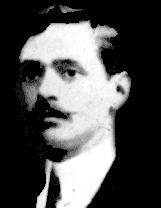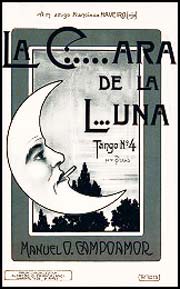By
La c...ara de la l...una. A picaresque tango, but without lyrics...

hat did Manuel Campoamor intend to say with his tango “La c...ara de la l...una”? Surely, more than what the suspension points suggest. The c of the case alludes to la lora (a polly), in our slang (lunfardo), a woman.
 José Gobello encloses, in his definition, a quotation from Los amores de Giacumina: «...venimos a pedir il disaloco de la casa dunde vive ina lora que si chama Giacumina...» («we've come to ask the eviction from the house where a polly called Giacumina lives…»). A polly, a free woman, an arroyera (from the gutter).
José Gobello encloses, in his definition, a quotation from Los amores de Giacumina: «...venimos a pedir il disaloco de la casa dunde vive ina lora que si chama Giacumina...» («we've come to ask the eviction from the house where a polly called Giacumina lives…»). A polly, a free woman, an arroyera (from the gutter).
But for the case of this tango not the whole woman, but, specifically, a part of her, her sexual organ. That word we use and with which the Spaniards short the name of those called Concepción.
The case then, has nothing to do with the green-feathered polly, the parrot's partner.
Manuel O. Campoamor left memorable tangos, like “Sargento Cabral”, “La metralla” and “La franela”.
On request of a distinguished bacán (aristocrat) from the Jockey (he refers to the Jockey Club), Domingo Greco —Vicente's brother— played Campoamor's tangos nothing less than before Arthur Rubinstein, with the approval of the great pianist.
Campoamor was an excellent piano player, of strong touch, similar to the Vicente Greco's energic drive, Héctor Bates and Luis Bates —authors of the work titled La historia del tango (Buenos Aires, 1936)— gather the memories and even the complaints by Campoamor, in an interview made on Radio Stentor, on July 18, 1934.
He was by then a man of rather short stature, looking-glasses, with an air of serious office worker, as he really was. He had learnt telegraphy. He later entered Gath & Chaves store and worked in the accounting section, after successive promotions he became secretary of the board of directors. He was dismissed after nearly twenty five years' service.
 Of his music he said: «I wrote my first tango “Sargento Cabral” in 1899. I'd rather say somebody wrote it for me, because I never learnt music. I learnt piano by ear, firstly with a finger, then with two and a little bit later, I played some pieces with both hands... Two friends were responsible for committing to paper what I played on the piano.
Of his music he said: «I wrote my first tango “Sargento Cabral” in 1899. I'd rather say somebody wrote it for me, because I never learnt music. I learnt piano by ear, firstly with a finger, then with two and a little bit later, I played some pieces with both hands... Two friends were responsible for committing to paper what I played on the piano.
«When I was 19 I played in public at some Carnival balls. I made myself be known, achieved fame and became a much requested and popular person. It was then when I tried to start the recording of folk music discs in Argentina. They called me and I recorded Sargento Cabral as a piano solo. Later I recorded accompanying Gabino Ezeiza, Higinio Cazón, Linda Thelma and others who were stars then».
He said of Gabino Ezeiza: «We've been together traveling from one place to another and I had the chance to confirm how much all the people admired him. It was a delirium, especially when he started to ad lib...»
The tango “La c...ara de la l...una” was composed by Campoamor in 1901. In 1902 he composed “La metralla”.
These admirable orejeros (players by ear) had, no doubt, a creativeness and imagination which is impossible to be acquired at Conservatories, because of that which says «lo que natura non da...»
The author was poet, art critic, lawyer and researcher of daily life and the city of Buenos Aires and a member of the Academia Porteña del Lunfardo. Published in the magazine Desmemoria nº 19/20.